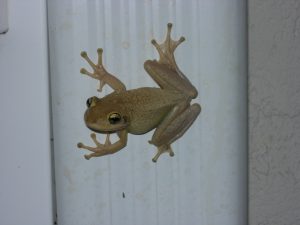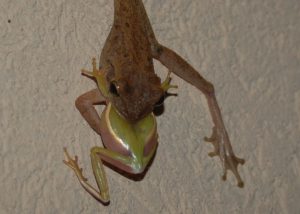Guest Blogger – Dr. Steve A. Johnson, Associate Professor & Extension Specialist, Department of Wildlife Ecology and Conservation, University of Florida
The National Invasive Species Council defines an invasive species as one that is introduced outside its native range where it causes harm (or is likely to) to the environment, economy, or human quality of life. The Cuban Treefrog in Florida qualifies as invasive under all three parts of this definition. Introduced from Cuba to Key West inadvertently in a shipment of cargo about 100 years ago, this frog is now established throughout Florida’s peninsula, and isolated records from numerous panhandle counties continue to accumulate. There are many records of Cuban Treefrogs from other states in the US, and even Canada. Most of these frogs originated in Florida and found their way to points beyond as hitchhikers on vehicles or as stowaways in shipments of ornamental plants. Fortunately, Cuban Treefrogs do not appear to have gained a permanent foothold—yet—outside of the Sunshine State.
Cuban Treefrogs are well documented predators of Florida’s native treefrogs and are likely responsible for declines in native treefrog numbers, especially in suburban neighborhoods. Fortunately, research has shown that when native frogs (e.g., Squirrel and Green Treefrogs) are still present that they respond favorably to the removal of their invasive cousins. Cuban Treefrogs are known to seek shelter in electrical utility equipment or even a home air-conditioning units, and as they climb around they may cause short circuits, leading to costly repairs. They also invade homes, ending up in a toilet at times, and have also sent young children to the emergency room. The frogs exude a noxious skin secretion when handled, which is extremely irritating to mucous membranes, especially one’s eyes. So be sure to wash your hands thoroughly after handling a Cuban Treefrog.
To mitigate the negative impacts Cuban Treefrogs are having on Florida’s native wildlife, as well as their effects on our quality of life, I recommend that these invaders be captured and humanely euthanized. For tips on how to capture, identify, and humanely euthanize these frogs visit http://ufwildlife.ifas.ufl.edu/ and also read “The Cuban Treefrog in Florida”. Report sightings of this species outside of the Florida peninsula to Dr. Steve A. Johnson, and within the peninsula report them on EDDmapS.
![]()
Posted: March 2, 2017
Category: Invasive Species, Natural Resources
Tags: 2017, Cuban, Florida, Invader, NISAW, Panhandle Outdoors, Treefrog—Invasive



